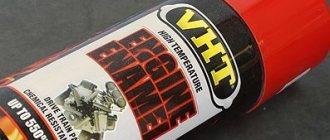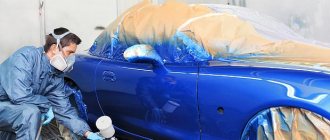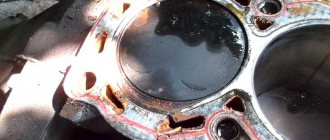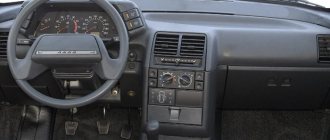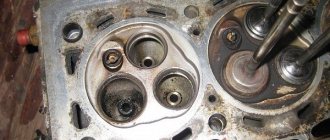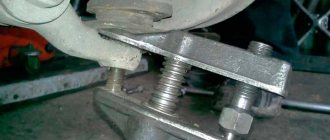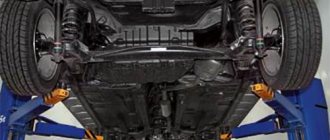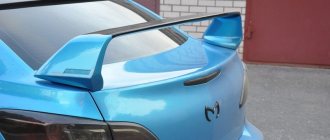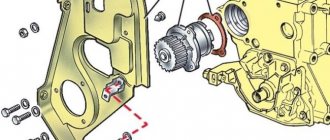People love not only to look, but also to touch. It is because of this that the front panel of the car - the dashboard - becomes a victim of gentle and not so gentle touches. It loses its luster not only because of frequent “stroking”, few people stand on ceremony with it and carefully put their things there, more often they throw it away.
And after this, the objects do not end their destructive effect; they continue to crawl unsecured along the soft surface of the panel, causing even more damage to it.
Let us reassure you, you don’t have to buy a new torpedo; sometimes it’s enough to properly paint it. How and with what, let's see below.
DIY torpedo painting
In order for the painting of the torpedo to be successful, you need to fulfill all the requirements that are relevant for the repair of cars and other metal structures:
- The room for painting should be sufficiently bright and clean.
- Good air circulation.
- It is better to paint a torpedo using a spray gun, since the can applies the liquid unevenly.
How to paint a car dashboard? There is a wide range of paints from different manufacturers. Water-based products are ideal for home renovations because they do not emit toxins or harmful fumes.
vehicle interior
Powder paints are relevant for professional restoration work, as they require high-quality baking. When working with paints and varnishes, be sure to wear a protective suit, including a respirator, goggles and gloves. You can wear old, unwanted clothes to paint the dashboard, but other protective elements should not be ignored.
Restoration of a car dashboard proceeds as follows:
When the spray gun is ready, you need to start the painting process with the smallest details.
This does not threaten experienced car owners, but it is still better not to risk the most noticeable part of the car’s decoration.
You need to paint in thin layers:
- the first is the thinnest, the overlaps should be minimal, that is, each strip should be flush with the previous one;
- the second one is applied 3 minutes after the first one, without allowing it to dry completely;
- the third is similar to the first.
The varnish is applied 20 minutes after the 3rd coat of paint. Two layers are enough. The dashboard takes several days to dry. After 2-3 days, you can check for paint smudges and sand them if any are found. Then the torpedo is installed at its workplace.
Features of torpedo painting
car torpedo
Painting the instrument panel yourself is a complex and time-consuming process, but there are other methods for updating the dashboard. There are 3 ways to change the dashboard:
- full painting;
- leather covering;
- vinyl covering.
Let's look at each in more detail:
Repairing a car's dashboard with your own hands using paint or painting the dashboard with liquid vinyl is considered the most common method for changing the interior appearance of a car.
The plastic from which the do-it-yourself torpedo is made lends itself well to painting from any device: a spray gun or a homemade spray gun, as well as a simple brush. The difficulty in painting the panel is that the preparation process is long and requires care when working with battery contacts.
Covering a dashboard with vinyl film is a relatively new method of restoring a panel. The coating can be glossy or matte. A wide range of colors will simplify the choice of the desired shade and solve the problem of mismatching the tone of the car and the dashboard.
Vinyl coating is resistant to wear and light mechanical damage. The film is applied in one layer and layer, which makes the process difficult for those who are working with it for the first time. The plastic that most panels are made from does not hold the vinyl, resulting in poor adhesion, making it impossible to restore the car panel.
Finishing with leather or a substitute is an expensive method that is popular with masters of refined taste who do not spare money on luxury. Leather is a durable material that lasts a very long time. It does not wear out or fade. Leather covering is performed only by professionals, as it has many nuances and complexities.
Popular color
How to paint a torpedo, what shade is appropriate? Car dashboard repairs are carried out with an emphasis on color. The shade of the torpedo is selected depending on the color of the car’s interior, but despite this, many car owners prefer the following shades:
- Titanium – Titanium nitride is applied to metal products and plastics. It has a golden color, so it is especially suitable for various types of fittings. Titanium coating protects the surface from scratches and abrasion. Experimenting with titanium allows you to create a matte and dazzling effect.
- Anthracite is a charcoal color with a slightly dusty effect. Harmonious anthracite is similar to the shade of night, so it will go well with any color of the car interior.
Restoring a torpedo with your own hands takes a lot of time, but the result and cost-effectiveness of the process exceeds all expectations.
Torpedo restoration options
We can briefly consider the available methods for restoring a car dashboard. These include the following methods:
- paint with acrylic enamel and varnish;
- matte enamel painting;
- paint with a rubber-containing compound;
- pasting with vinyl film;
- finishing with leather or its substitute.
As mentioned above, the easiest and cheapest way to return a decent appearance to a torpedo with your own hands is painting and applying a layer of varnish. Some people prefer matte enamels, since deep gloss can cause glare from the sun and interfere with driving. It all depends on the shape of the torpedo and the taste of the owner of the car. In most cases, preference is given to a glossy surface.
Subtleties of the dashboard painting procedure
Panel painting kit: primer for plastic (primer), paint and varnish
High-quality repair of the dashboard is only possible when using suitable paints and varnishes. Moreover, it is not so much the paint that is important, but its compatibility with the material from which the panel elements are made. In addition, it is necessary to take a responsible approach to the choice of varnish in order to obtain an attractive and durable glossy finish as a result. (Although it is not necessary to cover with varnish.) Care must be taken that the conditions in the room in which painting work is planned meet the requirements: it must be clean and not dusty. Otherwise, even the smallest particles of dirt caught in layers of paint or varnish can ruin everything.
It is recommended to moisten the concrete floor of the room (in this case, dust from it will not rise into the air) and clean the ceiling (if this is difficult to do, you can cover the work area with plastic film).
Preparation for restoration work
Before starting work, it is advisable to acquire all the necessary materials and accessories. After all, the car will be disassembled, and it will be very difficult to quickly go to the store for the missing piece of sandpaper. To paint a car dashboard, you need to prepare the following materials:
- means for degreasing the surface before painting;
- detergent for cleaning the car dashboard from dirt and dust deposits;
- tools for dismantling the panel;
- sandpaper of different grits from P500 to P2000;
- special primer for plastic parts;
- paint of the desired color;
- varnish;
- abrasive polish for working with a layer of varnish.
Additionally, you should take care of the room in which the car dashboard will be painted, where there should be no dust or large drafts. A normal temperature regime is also required, which is indicated on cans of paint and varnish. It would be a good idea to ensure uniform lighting, so as not to be upset later by defects discovered when leaving the garage.
Materials and equipment for painting a torpedo
As with everything else, be sure to familiarize yourself with the material from which the front panel is made. To find information, just look at the technical documentation for the car or ask the owners of the same cars on specialized forums. This must be done not only because of the production process; in some cases, the plastic that is used in the vast majority of cars, when interacting with oxidizing paint, begins to release harmful substances, which you will probably inhale for many years. What is it: carcinogens or teratogens? It’s up to chance. A sales consultant will help you choose the paint; he must understand the composition of the product he offers.
First of all, before you start repairing a car with your own hands, degrease the surface. This is done in several ways:
- Laundry soap is the easiest and cheapest way. You can find this substance even at 3 am in a rural store.
- White spirit is a traditional solvent, available in any hardware store.
- Special sponges impregnated with a degreasing composition. This is the most advanced and safest option; in this case, you will be practically deprived of the opportunity to harm yourself and your car.
After choosing the type of paint (acrylic, rubber) and color, you need to decide on the painting method. For example, local areas can be painted using a pressurized aerosol can, after first removing the part from the parent element. Two 150 ml containers are usually enough for all the work.
Mechanical cleaning of the torpedo is carried out with sandpaper of various grain sizes (No. P100, 200, 450, 650, 1000). In some cases, the use of small grinders is acceptable.
You will also need: a primer (for plastic with a plasticizer) and varnish. Both formulations are available in the form of aerosols, convenient for use.
What will be needed to complete the work?
Sandpaper (coarse and fine), sanding machine for large jobs.
Spray gun or compressor. At worst, you can use a vacuum cleaner equipped with a special attachment. No, well, you can still try to paint with a brush. But, most likely, it won’t work out so evenly and well. Stripes and bumps may appear, but do you need this? Spray gun or compressor
What you will use to degrease the surface prepared for painting. Otherwise, the coating, applied again, can easily peel off after some time. You can degrease the surface either with an ordinary soap solution or with special means (for example, white spirit or napkins). Here the choice is yours - according to your budget and to your liking.
Using a brush and spray can
The brush works better on details. Whether you like it or not, in the process of work you will have to go over every uneven surface. In addition, applying paint with a brush ensures better adhesion. This coloring method has other features:
- Having dipped the brush into the paint, you must immediately squeeze it onto the edge of the can.
- Applying paint with a brush means that the paint has less contact with air, which means it takes longer to dry. There should be no dust in the room.
- You should maintain a constant angle of inclination of the brush.
- The thickness of the applied layer should be minimal, since the brush ensures that all irregularities are filled.
Using a spray can significantly speeds up the process, but before starting work it is better to practice and achieve uniform painting. Under no circumstances should there be dust in the room, as it easily sticks to wet paint. After applying the layer, you should wait until it dries. On average it takes 20-30 minutes, but each paint has its own time.
Price
The pricing policy for car panel painting is determined based on a number of indicators. The cost of paint, the complexity of the work, possible repairs during painting work, and the responsibility when painting luxury cars are taken into account. In monetary terms, everything starts from 1500 rubles and above. If there is competition, there is not much difference - a provincial town or a metropolitan car service center.
Most often, inside a car, its owner and passengers come into contact with the front panel - the dashboard. People simply call it a torpedo. Due to extreme operating conditions, it loses its aesthetic appearance over time. The causes of defects, in this case, are usually various kinds of objects carelessly thrown onto the panel; they damage its surface when the car moves. Painting the torpedo will help you get rid of all the bumps and scratches on this element.
Painting plastic car interior
- When painting interior plastic, the ambient temperature should be room temperature or higher, otherwise the paint will not spray well and dry.
- It is better to paint in a well-ventilated place. There must be good lighting. Place a large piece of cardboard, and on it something that will slightly raise the part to be painted above the surface so that you can paint it on all sides.
- Apply adhesion promoter or plastic primer. Apply the adhesion promoter in the same way as spray paint: a thin, even layer from side to side over the entire surface. After applying a layer of adhesion promoter (plastic primer), you need to let it dry. It is better to check the instructions on the container and wait the required amount of time, taking into account the temperature conditions.
- If acrylic primer has already been applied and sanded (see above), then it does not need to be coated with an adhesion promoter.
- Shake the can before spraying paint. The paint is applied in thin layers. Let the paint dry between coats. Turn the can over and clean the nozzle (blow out) between layers so that a new layer is sprayed through a clean nozzle.
- Apply thin, almost hazy layers. The goal is to create a surface that is evenly covered with paint, and not with chaotic spots of varying thickness. The number of layers can be from 3 to 6, depending on the color of the substrate and the color of the spray paint. Your task is to create the thinnest overall paint layer possible, while changing the color of the surface being painted (overlapping the substrate).
- Always spray paint in even passes, overlapping the previous pass by 50%. Move your hand at the same speed, spray at a distance of about 20-30 cm from the surface. When spraying paint, try to keep the nozzle perpendicular to the parts being painted. Each subsequent layer is applied until the previous layer is completely dry. To apply the next layer, the already applied paint must dry “sticky”, that is, when you touch it with your finger, the paint should not remain on it, but be sticky. This way the layers will fit together well.
- If paint runs or other defects occur during painting, it can be eliminated by sanding with P800 sanding paper when the paint dries, then clean and degrease the surface again and repaint.
- To complete the painting process, apply varnish to the paint. The varnish is applied if you planned to create a smooth glossy surface, like the photo below. It will give additional shine and protection. If a plastic part was painted with matte paint for plastic, while maintaining its texture, then varnish is not needed.
- The varnish can be applied either before the paint has completely dried (after 10–15 minutes), or after drying, but then the paint needs to be matted a little before varnishing.
- 2-4 thin layers of varnish will be enough. Allow 5-10 minutes between coats. After 24 hours, the varnish will dry, and you can proceed to installing the painted parts in place.
- Medium and large painted parts can be polished if desired (see article on polishing).
- To protect the fresh coating from scratches, dust and prolong the shine (if painted with gloss), use protective car wax. Apply wax to the new coating, avoiding the dashboard. Then, after 1 minute, rub the wax and remove excess. Good wax can last a long time. Repeat the application of the protective layer periodically.
- It is not advisable to clean a freshly painted surface with special salon products for a week. In the future, it is also better not to use aggressive cleaning agents, but to wash the painted elements with plain or soapy water and microfiber.
Preparing the surface for painting
The dismantled panel is thoroughly washed from dirt and dust using a high-quality detergent. Next, the surface of the car panel needs to be freed from minor defects. Often, a torpedo has many scratches that formed during its use, and which will be visible even after painting.
Abrasive paper is used to remove defects. If possible, you can use a grinding machine. However, this should be done extremely carefully, since the plastic can very easily be melted by high tool speeds. Thus, the surface of the torpedo is brought to a perfectly smooth state.
After sanding, you should clean everything from dust and degrease the panel. Do not forget that the work is carried out with plastic, so cleaning products should not react with this material. The easiest way is to use alcohol or even a simple soap solution.
Faded console
Made of plastic, the cabin loses its shine and beautiful appearance due to exposure to sunlight and ultraviolet radiation. When the dashboard is not in the worst condition, a special preparation for plastic restoration will be enough to update it. However, if the damage is significant, then the best solution would be to replace individual elements with new ones, which you can easily purchase and install yourself. To add shine and restore color to the plastic of the console, we recommend MOTUL E5 SHINE & GO. This is a silicone based aerosol for adding shine to all plastic surfaces. After using this product, a dry, shiny film remains, protecting against dirt, dust and preventing water from accumulating.
Additional recommendations
To create a dense and uniform coating, you must use only high-quality inks. Experts recommend buying products in small bottles with a sprayer. This will reduce the consumption of the substance. Work should be performed with gloves and closed clothing to avoid contact of the product with exposed skin.
Restoration of interior plastic
Important! The optimal distance to the surface during spraying is 25-30 cm. Compliance with this rule will prevent the appearance of streaks.
Results of do-it-yourself interior plastic restoration
It is not difficult to use restorative products, so if you want to improve the condition of your car’s interior, then you don’t have to go to a car service center and overpay. You just need to choose an effective remedy, trying not to save too much, and also allocate some free time. And you're done! The salon looks like new again!
How to paint interior plastic without the paint peeling off
Let's start by analyzing the main mistake: why does the enamel layer peel off? The reason is that the material has nothing to cling to, that is, weak adhesion of the paint layer to the primer or plastic.
The fact is that before applying any type of paintwork on the surface to be treated, it is necessary to create small grooves and scratches, that is, grind. This improves the adhesion of the new coating to the base, making it durable and resistant to peeling. What else is sanding useful for? During treatment with Scotch Brite, stubborn dirt that is difficult to remove with anti-silicone is removed.
Hard plastic painting technology
We have already outlined the main stages of restoration work in the selection of materials. Now let's look at the technical part of each operation.
- Sand it. According to painting terminology, this transition would be correctly called matting. The bottom line is that you need to moisten red Bright tape in anti-silicone and rub it on the plastic part.
- Degrease. Soak a cloth in anti-silicone and walk over the treated surface.
- Prime. Apply 3-4 layers of special primer for plastic and wait until it dries.
- Sand it. Treat the primed surface with Scotch Brite.
- Paint it. Apply 2-3 layers of paint of the desired color. If there is a need to restore the structure, then structural enamel is applied before the main painting. The places where it is sprayed are determined by location: this is either the entire surface of the part, or some of its sections. If the goal is to obtain a varnished surface, then 20-30 minutes after receiving the painted coating, apply varnish in 1-2 layers.
When painting interior plastic, follow the well-known rules for working with aerosol cans:
- Place the part in a closed room with an exhaust hood to prevent dust from entering the processing area.
- Cover untreated surfaces with newspaper, cardboard or thick fabric, securing it around the perimeter with masking tape.
- Shake the can for 1 minute to obtain an even layer.
- Try spraying paint on some cardboard. Check the color match and prepare the can to spray evenly.
- Apply paint/primer to the surface with quick but smooth and non-stop longitudinal movements. Drying time between layers at a temperature of +25°C averages 20-30 minutes. Complete polymerization occurs after 24 hours. When painting, shake the can periodically.
- Turn the can over and press the button. This is relevant if there is paint left in the container. This is done to ensure that the material does not freeze in the sprayer.
Working with Soft-Touch coating
We have already noted that the above painting technique is relevant for hard interior plastic. Plastic with a soft coating, such as dashboards or door cards, requires special treatment:
- The old soft-touch layer must be completely removed. If this is not done, the new paint will peel off again. To easily remove the coating, the part should be soaked in 646 solvent.
- When using original Soft-Touch paints, plastic is usually not primed, and one layer of coating is enough to successfully close the issue of restoring interior elements.
Restoring plastic with polish
Step 1. Prepare cleaner and polish. In this case, products from are used, but if you wish, you can take another brand.
Preparing cleaner and polish
Step 2. Dilute the concentrate with water in a ratio of 1:10.
Diluting the concentrate with water
Step 3. Pour the finished product into a plastic bottle and install the sprayer.
Installing a sprayer on a bottle
Step 4. Apply a layer of cleaner to the surface to be restored.
Applying a layer of cleaner
Step 5. Wait 20-30 seconds for the product to be absorbed into the interior material.
The product must be absorbed
Step 6. Wipe the plastic thoroughly with a regular dishwashing sponge.
Processing plastic with a sponge
Step 7. Using a wet cloth, carefully remove any remaining product from the surface.
Removing product residues
Step 8: Dry the plastic surface using a clean rag.
Wiping the plastic surface with a rag
Step 9. This is what the plastic looks like after cleaning.
Plastic after the cleaning stage
Step 10. Apply a thin layer of matte polish to the cleaned surface. The right side is polished, while the left side is only cleaned (for comparison).
Applying matte polish
Step 11. Rub the polish with a sponge to distribute the polish evenly. Then wait 5 minutes for the product to be absorbed.
Distribution of polish over the surface
Step 12. Clean the surface with a dry cloth. You need to rub in until the matte effect is completely achieved.
Wiping the surface with a dry cloth
Step 13: Done! The plastic has been restored and is ready for use. It is recommended to repeat this procedure every 2-3 months, and then the salon will always look like new.
The interior plastic panel has been restored
Liquid vinyl treatment
Liquid vinyl is a modern product that is successfully used for painting car parts. A thin layer of this coating decorates and protects many suitable surfaces well. This is a high-tech product of excellent quality. Treatment with liquid vinyl will increase the resistance of the panel to the influence of bright rays of the Sun, ice, frost or other harmful compounds. The beauty of this substance is that after prolonged use it comes off easily. And this fact does not reduce its strength qualities.
Painting with liquid vinyl is a simple and understandable procedure for everyone. The processed part will become matte and clean. Liquid vinyl is usually sold in cans. Before use, you need to shake it, it is advisable to do this for at least a minute. The paint and solvent must mix well. Do not touch liquid vinyl until it is completely dry. Otherwise there will be stains.
The process takes place in several stages. The initial level is connecting. They try to make it translucent. This makes it possible to bond the paint to subsequent levels. The first layer will dry for about 30 minutes, this time must be maintained. The number of layers applied depends on you. The more there are, the more durable the coating will be. The recommended quantity is five. Distance from the can to the torpedo: 7 - 9 centimeters. If you did not dismantle the torpedo and sealed parts that were not to be painted, remove the tape and protective material immediately after painting, before the vinyl hardens. The complete drying time for vinyl is 3.5 hours. All this time it is necessary to protect the drying surface from dust and other bodies.
Interior preparation and processing of old paint
The plastic in the car interior needs very high-quality processing. The specificity of painting materials is such that incorrect application will result in drips, color transitions and unpainted parts. All this causes certain difficulties. Interior plastic paint can adhere normally only if the part is first prepared. To do this, a fairly simple procedure is performed with the following procedure:
Parts are removed from the car
This must be done carefully, as some plastic elements are very easy to damage. If we are talking about the panel and door cards, you can leave them in place, covering everything around
If the enamel is applied to a greasy and dirty surface, all the paint material will simply run off. So, to begin with, the plastic is degreased and cleaned of all kinds of contaminants.
The next step is to sand off the old paint using water and fine-grit sandpaper. Use P 1500-2000 on a waterproof base and constantly feed water under the abrasive.
Next, the interior is protected from paint getting on all kinds of elements, otherwise you will have to scrub them off later. To do this, use thin masking tape and film or newspapers to create protective screens.
The last thing you should do is degrease the surface again and apply paint with gentle movements. This will help to quite easily maintain the evenness and quality of the plastic surface and restore freshness to the interior.
In order for the car to become beautiful again, you must apply the purchased materials efficiently and without errors during the work process. Otherwise, the paint will run off, will not dry, or will be very different in color. Remember also that when painting local plastic parts you will have to use the transition painting method. This is not possible using a spray can; professional equipment will be required. Interior plastic paint is sold not only in aerosol form, but this is the most convenient way to use it.
Self-restoring the paintwork of the front panel of a car
Next is the actual painting of the torpedo with your own hands. Spray a base coat of enamel first. It is, in essence, a darkroom. In other words, it will show you poorly primed areas of the front panel of the car. If they appear, straighten them by applying an additional coat of primer.
After waiting 15 minutes for the base coat to dry, then apply a second coat of paint. Make sure that the composition is sprayed as evenly as possible over the surface being repaired. Next, if necessary, apply a third layer of enamel. Be sure to clean the torpedo from any accumulated dust with a special napkin before spraying each layer.
Having finished painting, after 15 minutes proceed to applying varnish. Working with it is done in the same way as with enamel. Two layers of this paint and varnish material will be enough. After completing this step, leave your car's front panel to dry for a few days. Then you can polish the restored part if you find any smudges on it.
If you are satisfied with the result, painting the torpedo is completed by installing it back into the car interior.
You can often come across the question: “What is a torpedo in a car?” The dashboard is a dashboard located at the front of the car and has a size similar to the length of the windshield. The dash includes everything from the steering wheel to the power windows.
painting the torpedo in leather color
The dashboard can be made from any durable material, but is usually hardened plastic. It is easy to process and holds the paintwork for a long time. Over time, the torpedo wears out, the color becomes dull and significantly spoils the interior appearance of the car.
To get rid of this drawback, it is quite enough to repaint the instrument panel with your own hands.
Stages of self-restoration of auto plastic
Carrying out restoration of automotive plastic with your own hands is not at all difficult. To do this, you need to purchase all the necessary materials and understand the sequence of actions.
Materials required for restoration
In order for the work on restoring auto plastic to be of high quality, it is necessary to prepare in advance the materials and tools that will be needed during the work:
- Solvent or degreaser.
- Primer for plastic surfaces (if necessary).
- Moisture-resistant sandpaper.
- Paint on plastic.
- Colorless acrylic varnish.
- Brushes of different sizes.
For the restoration of plastic parts, it is optimal to use paint in a can, since operating a spray gun in the interior is inconvenient due to limited space, and purchasing equipment is not a cheap pleasure.
Dismantling elements before painting
Removing parts to be processed is one of the important stages in preparing to paint the car interior. The fastening of the elements is different for each car model, so dismantling may cause some difficulties.
While disassembling the dashboard of a domestic car (for example, a Lada Priora) with your own hands is not difficult, dismantling the plastic elements of the interior of foreign cars often requires special tools. A set of universally applicable tools will greatly facilitate the task.
It is necessary to remove the plastic carefully and carefully to prevent breakage of clips, latches and loss of small parts. To facilitate the assembly process, it is recommended to take intermediate photographs of the dismantling process.
universal kit for dismantling plastic car parts
Preparing plastic for painting
Before painting the plastic inside the car, it must be carefully prepared.
Preparing parts for painting is carried out in several stages:
- Removing dust, dirt, degreasing. To clean the surface, you can use acetone, white spirit, or solvent.
- Removing traces of old paint using sandpaper dipped in water.
- Next, you need to cover the plastic elements in the car that cannot be painted so that you don’t have to clean them later. To do this, use masking tape, newspapers and oilcloth.
- The next stage of preparation is repeated degreasing and application of an adhesion enhancer.
How to paint the plastic of a car interior?
The consistency of painting technology will ensure a durable and reliable paint coating. Painting car interior elements consists of several steps:
- The paint is sprayed or brushed onto the surface in two or three layers, depending on the desired depth of color and the condition of the plastic. Each layer must be dried for half an hour. Using an industrial hair dryer for drying will significantly reduce painting time.
- After applying and drying the final layer of paint, the surface is coated with clear varnish in one or two layers.
- The finished surface is polished with a special paste and a soft cloth.
Features of painting a car panel with your own hands using a brush
It is more convenient to paint some plastic elements of the car interior with a brush. The brushed paint guarantees excellent adhesion and coverage of small parts and rough surfaces. However, when painting you should consider:
- Car interior plastic paint applied by brush requires a longer drying time. The drying process of each layer increases by an average of 20 minutes.
- To keep the paint layer as thin as possible, you need to work quickly with a brush and, at the same time, press the tool tightly against the surface.
- To avoid smudges, it is necessary to remove excess paint from the brush on the edge of the container.
- To obtain the most even coating, the painting angle should be the same.
Torpedo dismantling
Painting begins with dismantling the torpedo. If this procedure is being done for the first time, then it would be a good idea to first read the instruction manual for the specific model. This is necessary in order to find out the locations of fasteners, which in most cases are carefully masked. There were many cases when, due to one fastening, a torpedo was dismantled by force, resulting in irreparable damage.
When the location of the fasteners has been studied, the steering wheel and all switches on the panel are dismantled, if their design allows it. Next, the instrument panel is removed and disconnected from the wiring. After removing all the plugs hiding the panel fastenings, they are turned out and neatly folded with marks. When everything is ready, the torpedo is removed from the latches and removed from the cabin through the front passenger door.
When dismantling the panel, it is very important to mark the removed fasteners so that there are no unnecessary parts later. Some people practice taking step-by-step photographs of the dismantling process, so that in case of hiccups there are basic clues.
You need to be especially careful with the plugs and branded torpedo mounts, since if they are lost or damaged, they can be very difficult to get.
Painting sequence
The dashboard of a car can be painted by dismantling it or without interfering with the structure. Let's look at the sequence of painting the panel without the need to disassemble the entire dashboard.
Cover with tape all small parts that you do not plan to expose to paint. You can use masking tape or other suitable material. It doesn't hurt to think about the windshield, as well as the ceiling, because splashes and drops of paint can fly in all directions, depending on your accuracy; Next, degrease the surface you will paint. You need to apply the solvent to a suitable cloth or sponge, and then wipe the plastic of the panel. Wait a bit until the surface dries; After the acetone has dried, apply primer to the panel. Do not apply paint without first taking care of the primer, otherwise you will not get the desired result; Make a strong decision about the color before you paint the panel in your car. Changing it in the future will be more difficult than before painting. Classic black matte paint is well suited for a car of the same color
But if the car is not dark, pay attention to light colors: pale blue, light purple or light green tones. This will be even more interesting for a girl who is a car enthusiast; Paint the panel according to the instructions written on the paint package; If you haven't thought about how to polish a panel in your car, it's better to do it right now
After you apply paint to the dashboard, painting the panel is not yet complete. Wait three days until everything is dry, and then carefully treat the surface with a soft cloth to add shine.
Also, if you are using regular paint, coat it with varnish on top.
The described method is suitable for people who are not very knowledgeable about cars, but have enough self-control and steady hands to apply paint directly inside the car.
car interior with panel
If this doesn't work for you, you'll have to remove the dash in order to paint the dashboard without any problems. Here's the sequence:
- Place the car on a flat surface and turn on the handbrake;
- After opening the hood, remove the negative terminal from the battery: this will prevent accidental short circuit;
- Remove the dashboard plugs and decorative elements;
- Find the screws that hold the panel in place and remove them;
- In accordance with the instructions that came with the car, remove the steering wheel;
- After removing the steering wheel, turn the dashboard towards you: the dashboard in the car, in addition to the screws, is also held in place by wires that transmit readings to the sensors. Carefully disconnect these wires and remove the panel completely;
- As in the situation when the instrument panel paint was applied in the interior, wash the part, dry it and apply a coat of solvent. To be sure, it is also better to go over the panel with very fine sandpaper to remove minor defects and make the dashboard smooth;
- Car dashboard paint usually dries completely in three days. After this period, apply the varnish, wait until it dries, and return the instrument panel back to the car. If necessary, use the assembly instructions.
When you ask yourself what to paint your car dashboard with, you are faced with a wide range of colors to choose from. Many people would like to paint it in the color that is now in fashion. Well, it should be noted that many people tend to choose anthracite color for the instrument panel.
Previously, they were painted silver, but now there is no such trend. Titanium-look paint for car panels is popular, but it requires the application of varnish. Treat the surfaces well with varnish, especially those that will often come into contact with your hands, because the paint may remain on the skin.
https://www.youtube.com/watch?v=scXws-BMdaA
In general, when painting, try not to overdo it with colors. Everything should look restrained, neat, but not colorful or vulgar. Before you pick up a spray gun, read a couple of articles about design, see how others paint toolbars. And then you will be able to handle even such a difficult task, at first glance.
Next article: Do-it-yourself local car painting. Previous article: DIY spray booth, video and photo.
Do you want to know everything about car painting? Read more useful articles:
- We put stickers on the car. They are so different.
- Camera for painting cars price. This thing is expensive.
- Powder painting. All technology.
Interior protection
Do-it-yourself painting of alloy wheels
First of all, the plastic panel must be dismantled - the torpedo is carefully removed and removed from the car, trying to follow the instructions:
- First remove the terminals from the battery, thereby protecting all subsequent work of the technician.
- Remove all controls and parts located on the panel.
- Unscrew the fasteners and place them in a safe place according to the diagram so that the assembly process is not difficult.
- Next, you need to move the plastic dashboard and disconnect all wiring from the digital instruments on the panel.
- Now you should remove the panel from the car interior and remove the buttons, remaining fasteners and decorative elements from it.
Subsequent restoration work involves the presence of unpleasant odors, splashing of paint, and prolonged drying of the product. Therefore, following these brief instructions will protect the interior and adjacent surfaces of the car from contamination. And preliminary disconnection of the terminals will protect the technician from electric shock.
How to update the appearance of your car's dashboard?
- The first method is to paint the car panel. This is one of the most common and simplest methods. But, despite the fact that it is the most common, it is fraught with a lot of complex nuances that should definitely be known and taken into account. First of all, this is due to the fact that the surface of the dashboard cannot be called absolutely hard and this introduces some difficulties into the process called painting the car panel. To be completely honest, paint often doesn’t look as chic as we would like. But this type of interior renovation can always be done in such a way that it will be very worthy.
- The second method is covering with vinyl film. This method has not yet gained as much popularity as the previous one, but it should not be discounted. As for the films themselves, they are quite diverse. They come in matte, glossy and carbon-fibre finishes. You can choose any color according to your taste and color that harmonizes with the interior trim and the car itself. This method has both its advantages and disadvantages.
The advantages of this method include:
- application of the film as a single whole surface;
- excellent appearance;
- durable in use;
- unpretentious in care.
The disadvantages include the difficulty of applying the film. This is due to the fact that some torpedoes are made of plastic, which does not adhere to the film, so it is impossible to cover it.
- 3. The third method is covering with leather or leatherette. This method is the most expensive compared to such a method as painting a car panel, but, at the same time, the most luxurious. You will need to try very hard to implement this option, but the result will exceed all your expectations. It will be truly amazing.
- 4. The fourth method is flocking. The good thing about this method is that it is inexpensive. The quality of the coating is quite good and will delight you with its aesthetic appeal for many years.
Popular colors
Designers advise painting the dashboard in the same color as the interior, choosing a slightly lighter shade. This reduces the strain on the driver's eyes. To make the interior of the cabin original, you can use one of the current colors: anthracite (charcoal color with a dusty effect) or titanium (golden hue with matte or dazzling glossy effects).
Repairing a car dashboard using “liquid rubber” paint is popular. When dry, this composition forms a smooth, rich matte surface, pleasant to the touch and resistant to negative influences.
Restoring a torpedo after an accident or in case of loss of appearance during long-term use can be done with your own hands. The most popular methods of restoring this part are painting, vinyl wrapping, or reupholstering the dashboard yourself.
So that there is no problem of choice
When choosing paint for repainting the interior, you need to focus on the following parameters:
Chemical composition. It is best, of course, to use acrylic compounds
It doesn’t matter in what form this car paint is made - cream or paste, or in spray cans. Such compositions will not only be cheaper, but also safer, since when heated (especially in the summer), acrylic materials do not emit odors and do not evaporate harmful toxins. Consistency
If painting time is of fundamental importance to you, it is recommended to use aerosol cans. The surface repainted with their help dries completely within 1-2 hours after the end of the procedure, while pastes and creams require longer drying - at least 12 hours.
Color scheme You need to pay attention to this parameter if you are painting only certain parts of the car’s interior - steering wheel upholstery, dashboard surface, panels, etc. An incorrect selection of colors will lead to a completely predictable result - the old car paint will not “make friends” with the new one, and they will contrast against each other. If you decide to repaint the entire interior, or want to redecorate it in a “sporty” style, choose a color scheme will depend only on your own tastes. For example, for painting the seats you can use yellow (as in sports cars), for the steering wheel - black, white or red, and for other parts made of leather and plastic - absolutely any color (up to blue or even pink - if the car is driven by a woman ).
What to paint with?
Firstly, you will need primer and putty to seal the scratches and then sand them. Today, the auto cosmetics market offers a fairly wide selection of primers, both those that dry instantly and those that require some time for this process. The primer must not come into chemical conflict with the base material of the torpedo. As for the rest, the choice of the manufacturer’s brand is yours (if you are not quite sure, you can additionally consult with a specialist selling you the product or on the Internet).
Of course, you will need the right paint. The conditions are the same as when selecting a primer. Addition: so that it doesn’t bubble, doesn’t peel off (in light of this, don’t skimp on it too much). Also, choose a color suitable for the overall tone of the interior trim. You can order a lighter tone - this way, according to experts, your eyes will be less tired on long journeys.
{banner_content}
And one more thing: the paint is also sold in spray cans. Just in case, take another can of the corresponding paint number in addition to the main quantity - for blowing out small transitions and hard-to-reach places.
For the final coating you will need a varnish (urethane and two-component). Especially, it can be used for surfaces that often come into contact with parts of the body. This can significantly extend the life of the paint itself.
Applying paint
To paint the panel you will need appropriate paint in pressure cans. For high-quality coverage, two standard-sized cylinders will be enough. The paint is applied in several passes. First, the first layer is applied - it should be thin and sprayed from a greater distance. After applying it, you will be able to clearly see all the defective areas that were missed during sanding and priming. If there are any, then they are processed again either with an abrasive or a primer.
The second and third layers are applied more thickly from a standard distance. At the same time, you need to keep an eye on it. So that the paint does not leak and lies on the surface of the panel in an even layer. After this, the panel is left for some time to crystallize the applied coating. Existing defects are immediately removed and repainted.
Varnishing
If you decide to get a glossy effect, then the panel is additionally varnished. This is painfully easy to do. It is better to choose the varnish of the same brand as the paint and primer. This will provide more guarantees that the materials will not conflict with each other and will provide reliable coverage.
Varnishing takes place in two steps. First, apply the 1st layer with a small spray. The final one is applied more thickly, on the verge of drip.
Since the varnish is transparent, special attention should be paid to inspecting the treated surfaces. Here it’s not at all difficult to not see smudges or missing areas with individual lighting
Tips for painting a torpedo
For beginners, choosing the right paint for a torpedo seems quite difficult. It’s not worth saving on paint and varnish material, because a poor-quality coating can peel off or bubble. When buying paint in spray cans, you should immediately purchase a couple of packages so that the product does not run out at the wrong time.
When choosing a shade, you need to take into account that a dark tone will be more difficult to paint over later. Experts advise making the panel a little lighter than the interior trim - this way your eyes will be less tired during a long drive. You should not decorate the panel too brightly, because it will look provocative.
https://youtube.com/watch?v=xhBBkKevj7k
The use of special automotive paint will allow you to update an important element of the car with your own hands. With strict adherence to technology and accuracy, the torpedo will look stylish and modern without extra costs.
Selection of materials
Before you start painting, you need to prepare the materials so that you don’t fuss and run around hardware stores later.
To paint a torpedo you need to take:
- plastic panel cleaner;
- a degreasing composition that does not act aggressively on plastic (white spirit is suitable);
- sanding cloths;
- putty;
- primer suitable for plastic;
- paint (in a can or spray can);
- varnish for final coating (preferably 2-component polyurethane);
- fine mesh to filter out the paint and primer.
Instead of sanding paper, you can use a machine. But to process a torpedo by machine, the worker must have extensive experience. The plastic panel is textured and quite flexible; unprofessional actions can damage the surface and worsen the condition of the product. A sander running at high speeds can melt the plastic surface. Therefore, if you lack experience, it is better to use sandpapers.
Let's sum it up
Every car owner wants to make their vehicle more attractive. There are many ways you can implement this noble undertaking. But often methods involving professionals turn out to be too expensive. Therefore, potential customers of paint booths and service stations prefer to buy the necessary paint themselves and do the work themselves. It's much cheaper, but it doesn't always give you the desired results.
It is important to choose the right methods and tools
When working with plastic, you should protect the interior as much as possible from enamel and prepare the part for applying auto paint. Also, do not forget that there are quite a few brands on the market offering painting products in a variety of price segments. It is much easier to immediately buy good material and not overpay later for the restoration of poorly painted parts. It will be cheaper and more profitable in all aspects, and the owner of the vehicle will be able to show himself in taking care of his car.
Preparing tools
The purchased materials and tools must be placed in advance in a room specially equipped for painting the torpedo. Usually a garage is used for painting work.
See also
Types of paints for timber and how to apply the compositions inside and outside the house
The room should be dust-free, well lit, without drafts, with optimal temperature values indicated on the paint can. In addition to materials for preparing and painting the torpedo, you need to buy the following tools:
- paint roller or priming brush;
- spray gun - a manual or compressor-type spray gun for applying dye;
- spatula for putty;
- different screwdrivers to remove the dashboard, then attach it back.
A spray gun is necessary if you purchased paint in a can. If you will use dye in a can for painting, then there is no need to buy a spray bottle.
